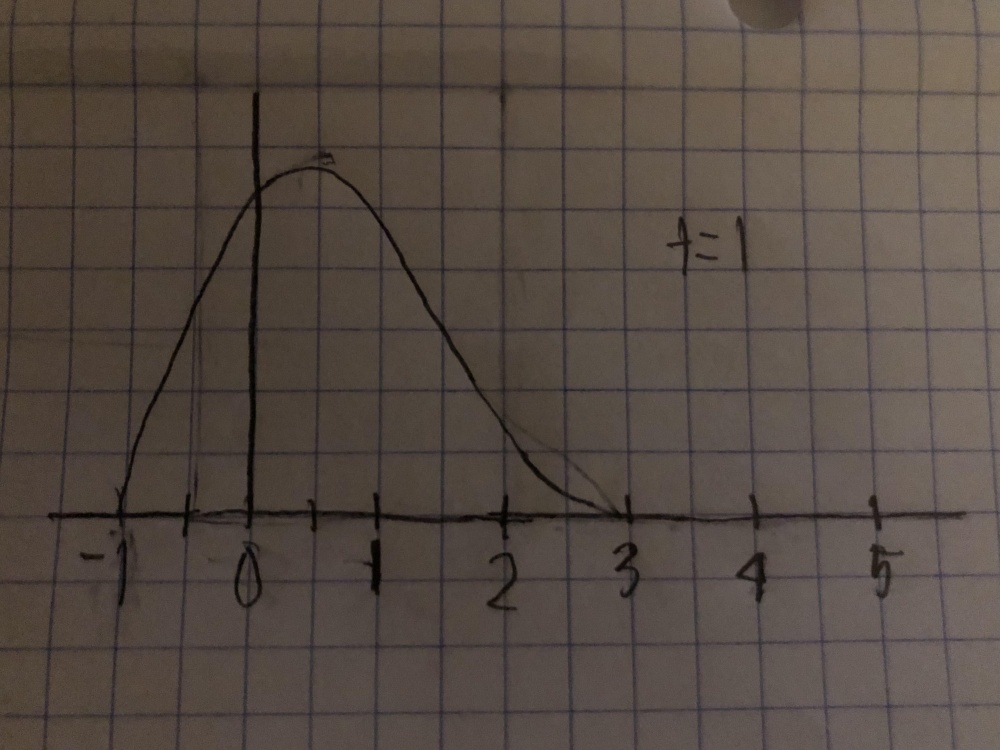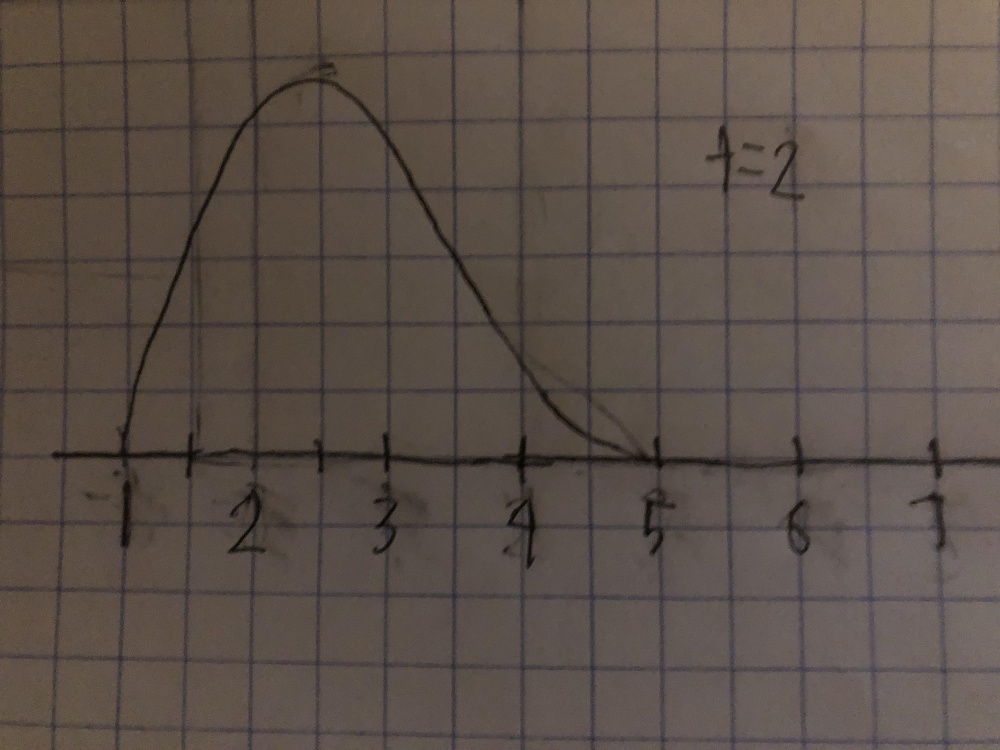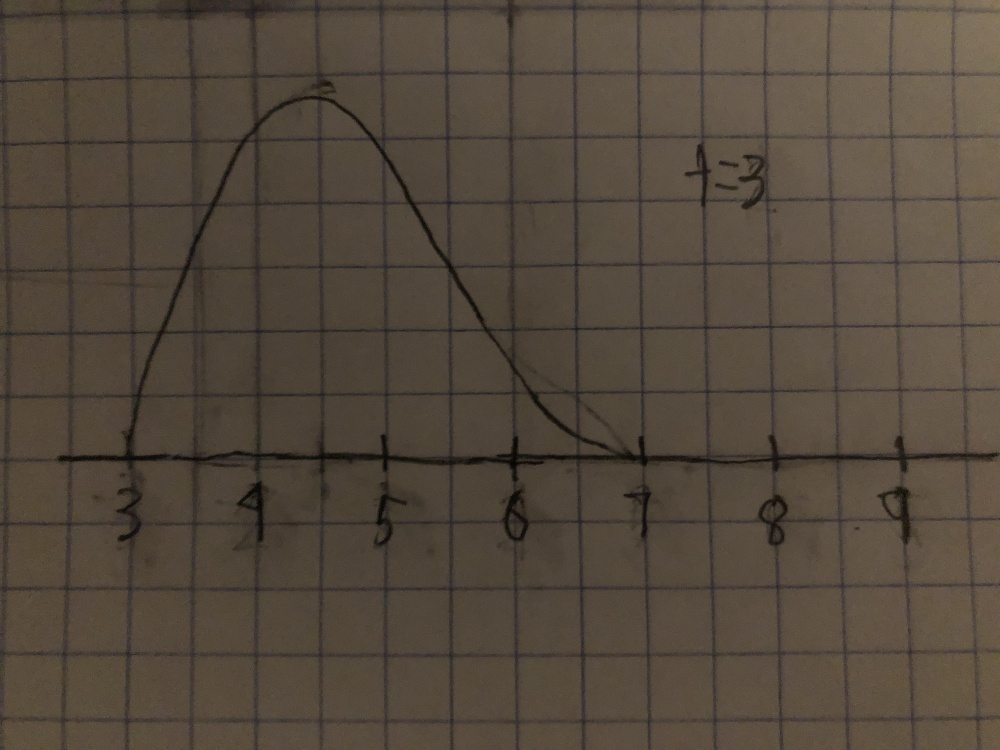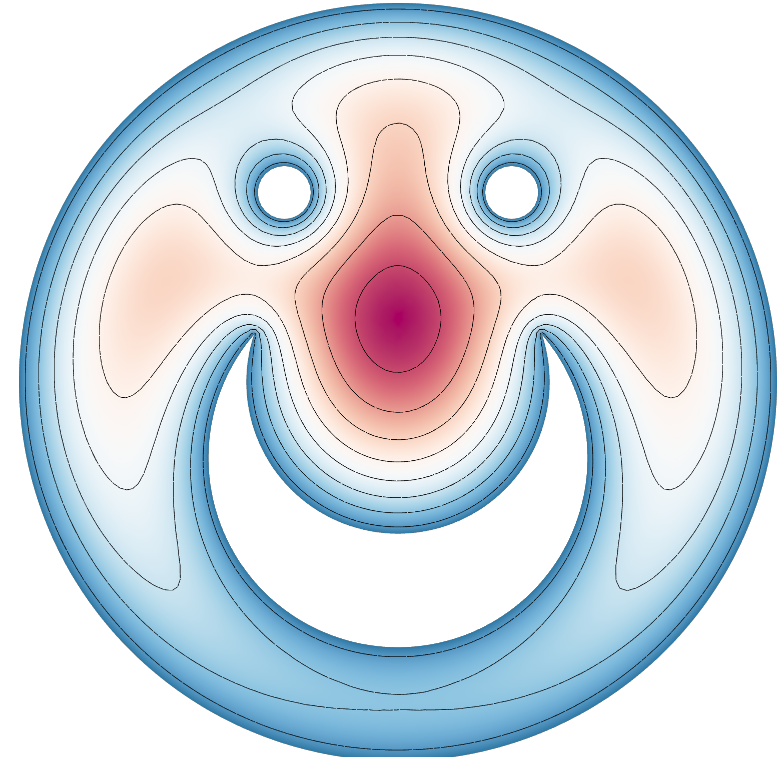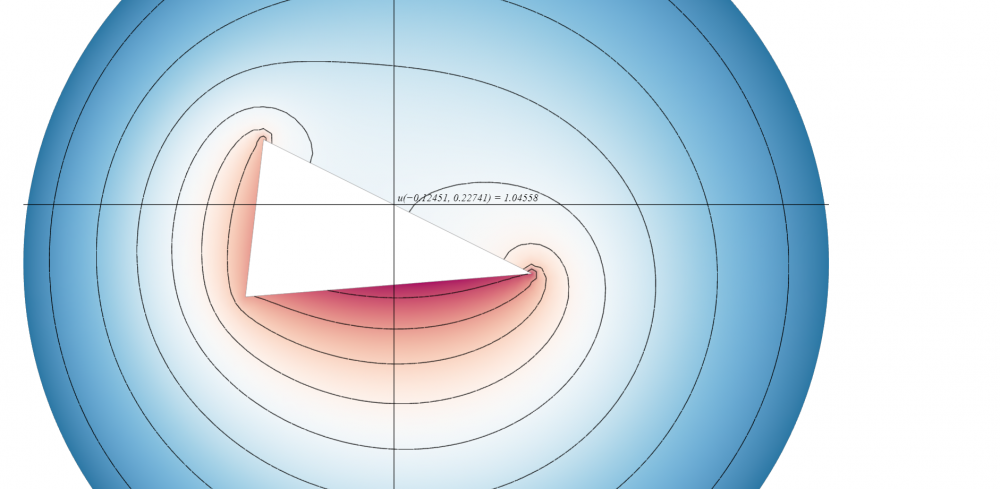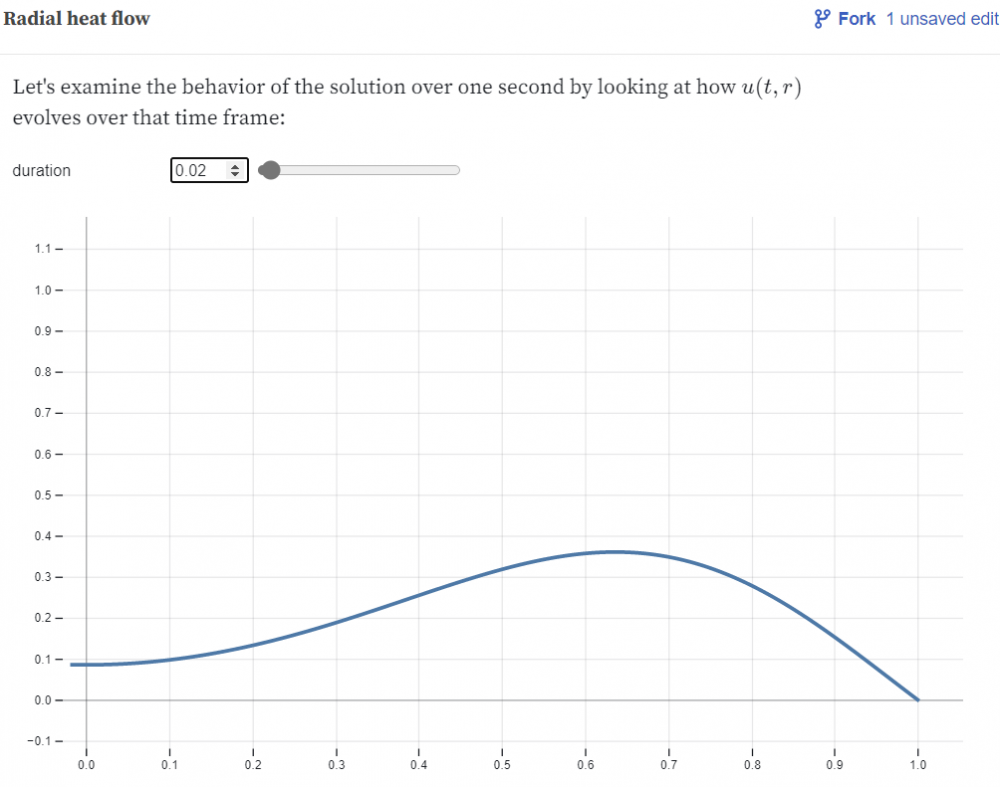-
A random vibration problem
-
Steady state heat flow with source
Heat flow with a constant internal heat source is governed by
$$u_t = 2u_{xx} + 6, u(0,t) = -1, u(1,t) = 4.$$
For a steady state temperature distribution, $u(x,t)$ does not change with respect to time, so $u_t = 0$. Hence, $2u_{xx} + 6 = 0$. Solving this equation for $u_{xx}$ yields $u_{xx} = -3$, and then integrating twice gives the solution
$$u(x,t) = -\frac{3}{2}x^2 +Cx + D$$
where C and D are constants. By setting $u(0,t) = -1$ and $u(1,t) = 4$, I was able to solve for C and D, and get a final solution of
$$u(x,t) = -\frac{3}{2}x^2 +\frac{13}{2}x - 1.$$
-
Burgers equation
Recall our basic conservation law expressed as a PDE:
$$u_t + \varphi_x = f.$$
Here we assume the source $f = 0$ and the flux $\varphi = \frac{1}{2}u^2$. Taking the derivative of the flux with respect to $x$ by using the chain rule, we find $\varphi_x = uu_x$. Plugging these variables back into the original equation, we get
$$u_t + uu_x = 0.$$
-
A first order IVP
This is an example of as advection equation of the form
$$u_t + cu_x +au = f(x,t)$$
$$u(x,0) = u_0,$$
where $c = 1$, $a = -3$, $f(x,t) = 0$, and $u_0 = x^2$. To solve this equation, we rewrite $u(x,t)$ as $U(\xi,\tau)$, where $\xi = x-ct = x-t$ and $\tau = t.$ By applying the chain rule, the PDE becomes
$$(U_{\xi}(-1) + U_{\tau}(1)) + U_{\xi}(1) = 3U.$$
SImplifying, we get
$$U_{\tau} = 3U$$
or
$$\frac{\partial U}{\partial \tau} = 3U.$$
We move all $U$ and $\tau$ terms to one side,
$$\frac{dU}{U} = 3d\tau,$$
and integrate:
$$lnU = 3\tau + \phi(\xi),$$
where $\phi$ is an unknown function of $\xi$. We then solve for U by raising $e$ to both sides:
$$U = e^{3\tau + \phi(\xi)}.$$
We simplify the right hand side using a technique familiar to students of calculus and ordinary differential equations:
$$e^{3\tau + \phi(\xi)} = e^{ \phi(\xi)}e^{3\tau} = \phi(\xi)e^{3\tau},$$
where we abuse $\phi$ to represent $e^{\phi}$ as is done with constants $C$ in calculus. it may seem odd that we can seemingly just transform an exponential function of $\xi$ into a regular one. Recall, however, that we do not yet know what the original $\phi(\xi)$ is, and it could very well be a logarithmic function, canceling out the exponential. We will get the same answer regardless when we plug in our initial conditions.
Hence our formula for U is
$$U(\xi,\tau) = \phi(\xi)e^{3\tau}.$$
Now we rewrite our equation in terms of $x$ and $t$:
$$u(x,t) = \phi(x-t)e^{3t}.$$
Finally, we plug in our initial values to solve for $\phi$:
$$u(x,0) = \phi(x) = x^2.$$
Our final solution, then, is
$$u(x,t) = (x-t)^2e^{3t}.$$
-
First order sketches
The solution to the PDE is
$$u = u_0(x - 2t),$$
so at each time interval, the graph above will shift to the right by two units. Here are sketches of the graph at each of the three times:
If we changed the PDE to $u_t + 2u_x = -u$, the solution becomes
$$u = u_0(x - 2t)e^{-t},$$
so $u$ will decay over time, approaching zero at large values of $t$.
-
Smile
-
Modeling 2D Heat Flow
-
Modeling a steady state heat distribution in 2D
-
Eigenranking
My matrix was:
matrix = [
[0,1,4,3,3],
[2,0,2,4,3],
[3,3,0,3,2],
[2,1,1,0,2],
[3,1,3,1,0]
]
and my ranking was:
Team 3: rating = 0.5054388063612655 Team 1: rating = 0.5016207712530641 Team 2: rating = 0.48157957363128245 Team 5: rating = 0.4108981576640922 Team 4: rating = 0.30356553355238997
Team 3 was the best.
-
A radial heat flow problem
(1) We start by separating variables, and assume $u(r,t) = R(r)T(t)$. Our PDE then becomes
$$(RT)_t = (RT)_{rr} + \frac{1}{r}(RT)_r$$ or
$$RT' = R''T + \frac{1}{r}R'T.$$
Dividing both sides by $RT$, we get
$$\frac{T'}{T} = \frac{R''}{R} +\frac{1}{r}\frac{R'}{R} = -\lambda.$$
Thus, $\frac{T'}{T} = -\lambda$, so $T' = -\lambda T.$ Hence,
$$T = e^{-\lambda t}.$$ Meanwhile,
$$\frac{R''}{R} + \frac{1}{r}\frac{R'}{R} = -\lambda,$$ so
$$R'' + \frac{1}{r}R' = -\lambda R.$$
This can be rewritten as $$-(rR'(r))' = \lambda rR(r).$$
The solutions to this radial differential equation are the Bessel functions $$R(r) = c_1J_0\left(\sqrt{\lambda}r\right) + c_2Y_0\left(\sqrt{\lambda}r\right).$$
Since $Y_0$ is unbounded at $z=0, c_2$ must equal $0,$ so $$R(r) = c_1J_0\left(\sqrt{\lambda}r\right).$$
From our boundary conditions, we know $$R(1) = c_1J_0\left(\sqrt{\lambda}\right) = 0,$$ so
$$\sqrt{\lambda} = z_n, n=1,2,3...$$
where $z_n$ are the zeros of $J_0.$ Hence, the eigenvalues are $\lambda_n = z_n^2$ and the corresponding eigenfunctions are $R_n(r) = J_0(z_nr).$ Thus, our full solution is
$$u(r,t) = \sum_{n=1}^{\infty}c_ne^{-\lambda_n^2t}J_0(z_nr).$$
(2) By our initial conditions,
$$u(r,0) = \sum_{n=1}^{\infty}c_nJ_0(z_nr) = 5r^3(1-r).$$
Since Bessel functions satisfy the orthogonality condition,
$$c_n = \frac{\int_{0}^{1}5r^3(1-r)J_0(z_nr)rdr}{\int_{0}^{1}J_0^2(z_nr)^2rdr}.$$
Plugging an initial condition $u(r,0)$ into the "Radial heat flow" ObservableHQ page gives us the normalized Bessel function $F(r)$ for each term of the solution and its constant coefficient, which we'll denote $b_n,$ where
$$u(r,0) = \sum_{n=1}^{\infty}b_nF_n(r) = \sum_{n=1}^{\infty}b_n\frac{R_n(r)}{||R_n||}.$$
Since $u(r,0) = \sum_{n=1}^{\infty}c_nR_n(r),$ it follows that
$$c_n = \frac{b_n}{||R_n||}.$$
We plug in $u(r,0) = 5r^3(1-r)$ and find that
$$u(r,t) \approx \frac{0.17333401324973097}{0.3670927157694067}e^{-z_1^2t}J_0(z_1r) + \frac{-0.18156860394077448}{0.24060355211655088}e^{-z_2^2t}J_0(z_2r) + \frac{0.0731801393963544}{0.16437392311147672}e^{-z_3^2t}J_0(z_3r)$$
$$= 0.4721804759e^{-z_1^2t}J_0(z_1r) - 0.7546380855e^{-z_2^2t}J_0(z_2r) + 0.4452052857e^{-z_3^2t}J_0(z_3r)$$
(3)
Using the same Observable page, with N=10, we graph the function at time $t = 0.02$:
(4)
Using the final tool on the Observable page with $N=10$, we find $$u(0, 0.02) = 0.086.$$


